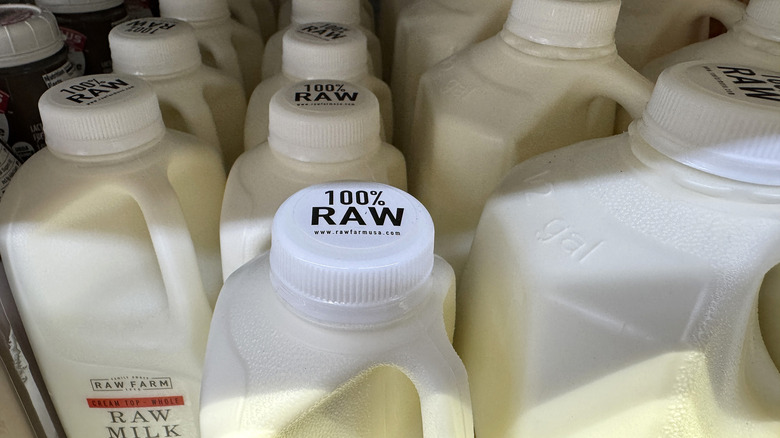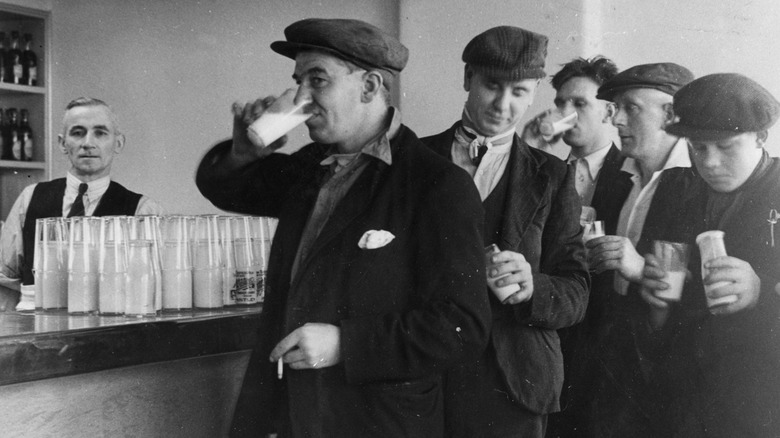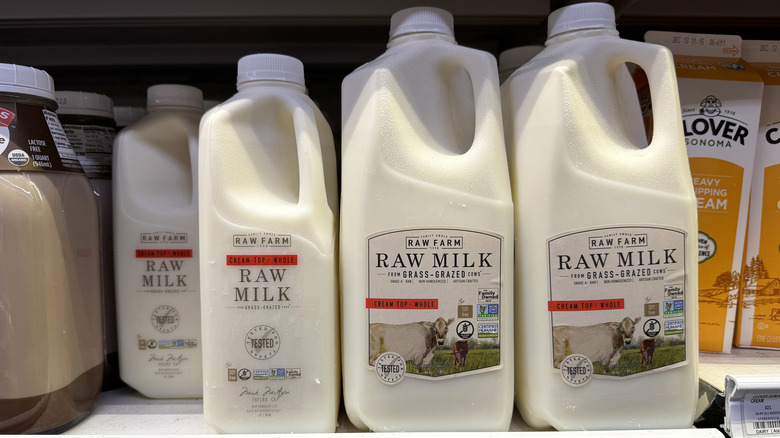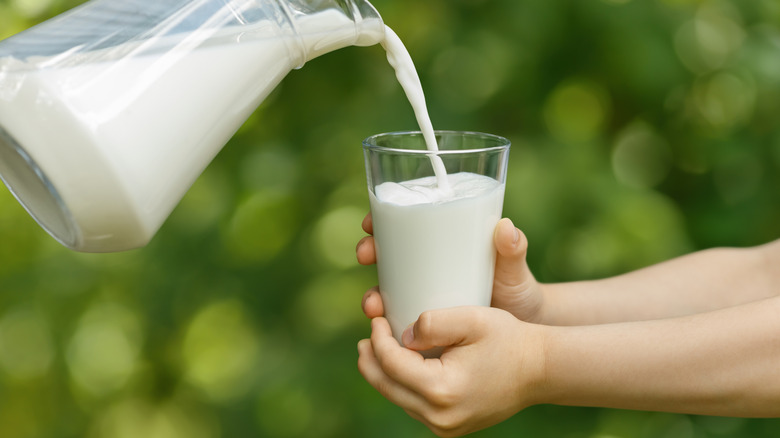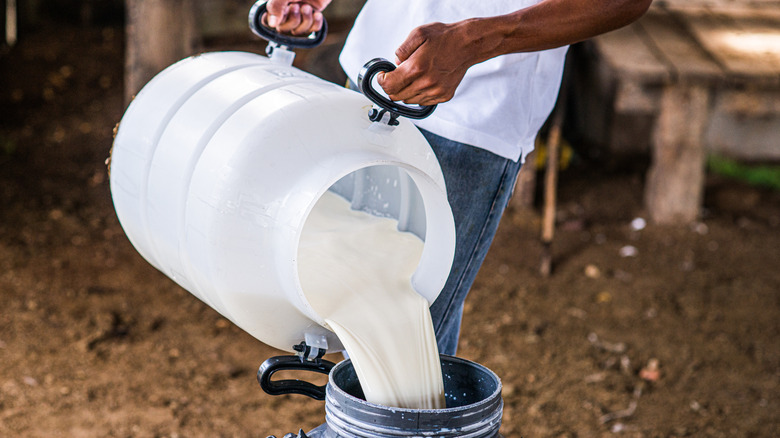The Biggest Raw Milk Recalls In US History
You've probably heard quite a bit about raw milk recently, with proponents claiming that consumption of the unpasteurized dairy item offers substantial nutritional benefits while also helping people overcome allergies and autoimmune conditions. However, an FDA review of existing research suggests that the science contradicting these and other health claims is incredibly strong. And because unpasteurized milk can harbor a multitude of harmful germs, like listeria, E. coli, and salmonella, consuming it can lead to serious, potentially life-threatening health issues.
Despite these risks, the sale of raw milk in retail stores is legal in a multitude of states, including Pennsylvania, New Mexico, Washington, Maine, Utah, California, South Carolina, and New Hampshire. In other parts of the country, such as Nevada, Arizona, Idaho, Oregon, and Connecticut, consumers can also find such products on store shelves with some restrictions. The raw milk craze shows no signs of slowing, despite the very real evidence of the harm it does. For instance, a paper published in the journal Epidemiology & Infection reported that unpasteurized milk was believed to be behind 675 bouts of illness across 75 outbreaks between 2013 and 2018. Of course, this is just the tip of the iceberg. We've compiled some of the largest raw milk recalls in American history to highlight the many risks associated with this unproven dietary fad.
Boston septic sore throat epidemic (1911)
A raw milk-related epidemic that occurred in Boston, Massachusetts more than a century ago illustrates why dairy products are among the many foods you should never consume raw (along with meat, flour, and certain types of beans). In 1911, what was believed to be either staphylococci or streptococci bacteria in the milk made 1,400 people sick. Some of them contracted the illness, which was then referred to as septic sore throat, through contact with others who'd directly consumed the tainted dairy. The effects included high fevers, stomach pain, and serious headaches. At least 48 people succumbed to the infection.
Dearfoot Farms, a long-standing Boston milk company, was implicated in the epidemic after extensive investigation. At the time, C.E.A. Winslow, a leading figure in the public health movement, stated that pasteurization was the only way to avoid future bouts of foodborne illness as they related to milk. Pasteurization had been discovered roughly 47 years prior to the Boston outbreak. However, the process started to become more commonplace in the United States around 1917, six years after the epidemic occurred.
Multi-state salmonella outbreak (2023 to 2024)
From 2023 to 2024, a Fresno, California-based business called Raw Farm was connected to an outbreak of salmonella believed to be caused by raw milk. The outbreak extended across four states and affected approximately 165 people, many of whom were children. The manufacturer was subject to numerous recalls by the California Department of Food and Agriculture during this time period, but it wasn't the first time the business had run into issues with its raw dairy products. From 2006 to 2016, Raw Farm (which was then operating as Organic Pastures) was also cited in eight outbreaks involving listeria, campylobacter, and E. coli.
AP News reports that Raw Farm has recently ceased production and enacted a sweeping recall of its products after samples taken from its manufacturing facility tested positive for avian flu. Bird flu infections in humans are rare, and there are no cases linked to this latest incident involving products from Raw Farm. Studies show that pasteurization can destroy the virus, providing yet another example of how the process helps safeguard against contamination.
Missoula, MT outbreak of drug-resistant salmonella (1980s)
Salmonella featured in a few of the recent U.S. foodborne epidemics, including some tied to onions and peaches. It was also a factor in a massive outbreak in the '80s involving residents of Missoula, Montana who consumed unpasteurized milk. There isn't much readily available information about the incident. However, a letter drafted by the Missoula Public Health department cited the outbreak in its opposition to Senate Bill 199, which aimed to remove restrictions on homemade food producers in the state. (The bill was passed into law in 2021.)
According to the health department letter, the raw milk made more than 100 people sick. Half of them were 14 years old or younger. There were also 15 hospitalizations linked to the outbreak. A subsequent investigation determined that there were no operational deficits that led to the outbreak. This highlights the problematic nature of raw milk, as there may be no indication of an issue until the people who've consumed it experience symptoms.
Idaho campylobacter outbreak (2024)
It's somewhat surprising that raw milk isn't on the list of food and drinks banned in America, especially when you consider that something thats harmless as Kinder Surprise Eggs did make the cut. Unpasteurized milk products continue to cause illness in the people who consume them, as evidenced by an outbreak of Campylobacter bacteria that occurred in Idaho this year. The contaminated milk caused illness in 18 people and prompted manufacturer Paradise Grove Dairy to voluntarily cease production to address the issue.
Campylobacter infections cause symptoms like fever, abdominal cramping, and diarrhea. While most people recover from symptoms within a week or so, there's also a risk of more serious health complications, including arthritis, irritable bowel syndrome, and Guillain-Barré syndrome, which is an autoimmune condition that can affect muscles. The extent of illnesses related to the Idaho raw milk outbreak aren't wholly evident, but the risk of debilitating illness is certainly not worth it when you consider that the stated benefits of raw milk are spurious by most accounts.
